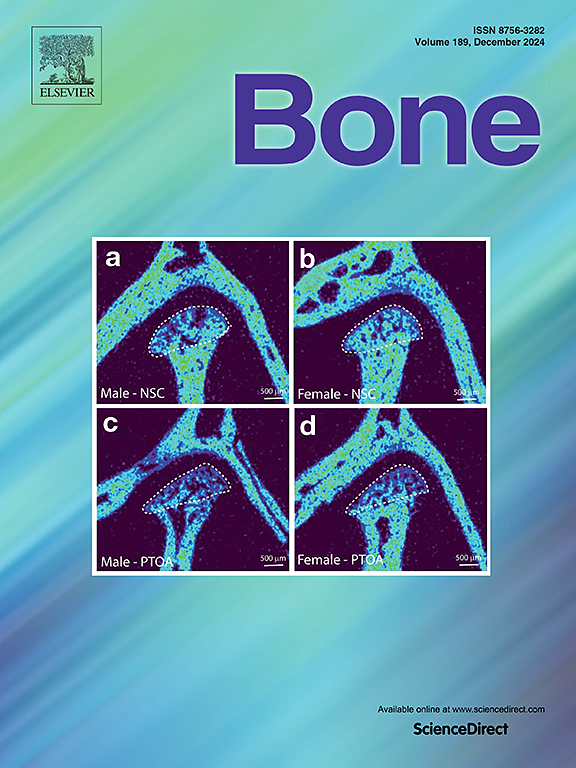Dentoalveolar defects and impaired alveolar bone healing in a neural crest directed conditional knockout mouse model of hypophosphatasia
IF 3.6
2区 医学
Q2 ENDOCRINOLOGY & METABOLISM
引用次数: 0
Abstract
Hypophosphatasia (HPP) is an inherited error-of-metabolism caused by loss-of-function mutations in ALPL-encoded tissue-nonspecific alkaline phosphatase (TNAP). HPP has wide-ranging severity, including a clinical subtype called odontohypophosphatasia (odonto HPP), which selectively affects craniofacial structures. Dentoalveolar defects in HPP can affect enamel, dentin, and alveolar bone, and deficient acellular cementum contributes to tooth loss. Global Alpl knockout phenocopies effects of severe HPP, but early lethality precludes longer-term studies. Aiming to create a mouse model replicating dentoalveolar effects of HPP, we used Wnt1Cre2 mice to conditionally delete Alpl in ectomesenchymal cells that make dentin, cementum, periodontal ligament (PDL), and alveolar bone. We compared appendicular and craniofacial skeletal effects of Wnt1Cre2 to Prx1Cre conditional Alpl ablation in limb bud mesenchyme. We also tested alveolar bone socket healing in Wnt1Cre2; Alplfl/fl conditional knockout mice and the effect of TNAP-Fc-D10 enzyme replacement therapy (ERT) on socket healing. Prx1Cre; Alplfl/fl mice exhibited 38 % reduced circulating alkaline phosphatase (ALP) and long bone defects, but no craniofacial phenotypes. Wnt1Cre2; Alplfl/fl mice featured 60 % reduced ALP and profound mineralization defects in dentin, cementum, and alveolar bone, but no appendicular skeleton changes. Defects were noted in neural crest-derived intersphenoid synchondrosis of the cranial base and mandibular condyle of Wnt1Cre2; Alplfl/fl mice. Extraction of maxillary molars in Wnt1Cre2; Alplfl/fl mice revealed profound alveolar bone healing defects that were partially rescued by ERT. Cranial neural crest deletion of Alpl resulted in a mouse model phenocopying odonto HPP that can be used to investigate mechanisms underlying pathologies as well as interventions.
神经嵴定向条件敲除小鼠低磷酸症模型牙槽缺损和牙槽骨愈合受损
低磷酸酶(HPP)是一种由alpl编码的组织非特异性碱性磷酸酶(TNAP)功能缺失突变引起的遗传性代谢错误。HPP具有广泛的严重程度,包括一种临床亚型,称为牙髓低磷症(odontohypophosphatasia,牙髓低磷症),它选择性地影响颅面结构。HPP的牙槽缺损会影响牙釉质、牙本质和牙槽骨,脱细胞牙骨质缺乏会导致牙齿脱落。Alpl基因敲除表型影响严重HPP,但早期致死率排除了长期研究。为了建立一个复制HPP牙槽效应的小鼠模型,我们使用Wnt1Cre2小鼠有条件地删除牙本质、牙骨质、牙周韧带(PDL)和牙槽骨的外间充质细胞中的Alpl。我们比较了Wnt1Cre2和Prx1Cre条件Alpl消融对肢体芽间质阑尾和颅面骨骼的影响。我们还测试了Wnt1Cre2的牙槽骨窝愈合;Alplfl/fl条件敲除小鼠及TNAP-Fc-D10酶替代疗法(ERT)对窝窝愈合的影响。Prx1Cre;Alplfl/fl小鼠表现出38%的循环碱性磷酸酶(ALP)减少和长骨缺损,但没有颅面表型。Wnt1Cre2;Alplfl/fl小鼠ALP降低60%,牙本质、牙骨质和牙槽骨存在严重矿化缺陷,但尾骨未发生变化。Wnt1Cre2的颅底和下颌髁的神经嵴源性蝶间软骨联合存在缺陷;Alplfl / fl老鼠。Wnt1Cre2上颌磨牙的拔除Alplfl/fl小鼠显示深度牙槽骨愈合缺陷,ERT部分修复。颅神经嵴Alpl缺失导致小鼠模型表型牙髓性HPP,可用于研究潜在病理机制和干预措施。
本文章由计算机程序翻译,如有差异,请以英文原文为准。
求助全文
约1分钟内获得全文
求助全文
来源期刊

Bone
医学-内分泌学与代谢
CiteScore
8.90
自引率
4.90%
发文量
264
审稿时长
30 days
期刊介绍:
BONE is an interdisciplinary forum for the rapid publication of original articles and reviews on basic, translational, and clinical aspects of bone and mineral metabolism. The Journal also encourages submissions related to interactions of bone with other organ systems, including cartilage, endocrine, muscle, fat, neural, vascular, gastrointestinal, hematopoietic, and immune systems. Particular attention is placed on the application of experimental studies to clinical practice.
 求助内容:
求助内容: 应助结果提醒方式:
应助结果提醒方式:


